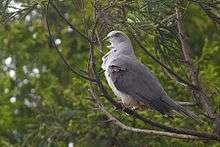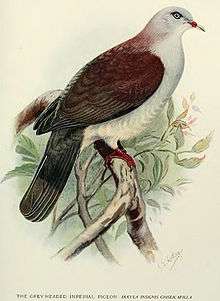Mountain imperial pigeon
| Mountain imperial pigeon | |
|---|---|
 | |
| Ducula badia insignis from Mahananda Wildlife Sanctuary, West Bengal, India | |
| Scientific classification | |
| Kingdom: | Animalia |
| Phylum: | Chordata |
| Class: | Aves |
| Order: | Columbiformes |
| Family: | Columbidae |
| Genus: | Ducula |
| Species: | D. badia |
| Binomial name | |
| Ducula badia (Raffles, 1822) | |
The mountain imperial pigeon (Ducula badia), also known as the maroon-backed imperial pigeon or Hodgson's imperial pigeon, is a species of bird in the pigeon and dove family[2] with a wide range in south-eastern Asia.

Description

The mountain imperial pigeon is the largest pigeon species in its range at 43–51 cm (17–20 in) long.[2] It has a fairly long tail, broad, rounded wings and slow wing-beats. The head, neck and underparts are vinous-grey with a contrasting white throat and brownish-maroon upperparts and wings, though the upper part of the body can be duller. The underwing is slate-grey and the tail is blackish with a grey horizontal line. The combination the maroon back with the large size give this species a distinctive appearance. Its call consists of a deep, resonant boom that is only detectable at close range.
Behaviour
Though usually solitary, this species has been seen in groups numbering up to 20, especially when going to roost or flying up or down in mountains. They can be difficult to see, since they spend their time usually in high canopy and usually fly fairly high over the canopy.
Breeding
During the breeding display, calling birds puff up their throats considerably while singing and bow to potential mates. Then the displaying bird engages in a vertical flight up from the perch, up 6 to 8 m (20 to 26 ft) into the air, and then glide back down with wings and tail widely spread. In the Northern stretches of the species range, breeding is from March to August, while in the southern parts of India and southeast Asia, they breed from January to May. The nest is usually in a fairly small tree, about 5 to 8 m (16 to 26 ft) off the ground, and is a flimsy platiform. One or, rarely, two eggs are laid and both parents incubate. They only leave the nest if highly pressed.
Feeding
They feed on fruits and berries, especially figs and nutmeg, which are plucked and swallowed whole. They will occasionally go to the ground to drink, as in Bornean mangroves where up to 200 or 300 of these pigeons have been flushed at once. There may be a partial altitudinal movement in some parts of their range, in pursuit of ideal feeding conditions.

Distribution and habitat
The pigeon has a wide range in south-eastern Asia, where it occurs in Bhutan, Brunei, Cambodia, China, India, Indonesia, Laos, Malaysia, Myanmar, Nepal, Thailand, and Vietnam. Its natural habitats are subtropical or tropical moist lowland forests, subtropical or tropical mangrove forests, and subtropical or tropical moist montane forests. It may be found from sea-level to elevations of 2,550 m (8,370 ft) in the Himalayas and 2,200 m (7,200 ft) on Sumatra. Being mainly a foothill bird, it probably only breeds above an elevation of 500 m (1,600 ft), although feeding flocks below this are common. It is usually found in old-growth forests. The species is generally fairly common where extensive stands of forest remain.
| Wikimedia Commons has media related to Ducula badia. |
| Wikispecies has information related to: Ducula badia |
References
- A Guide to the Pigeons and Doves of the World by David Gibbs, Eustace Barnes & John Cox. Yale University Press (2001), ISBN 0-300-07886-2.
- ↑ BirdLife International (2012). "Ducula badia". IUCN Red List of Threatened Species. Version 2013.2. International Union for Conservation of Nature. Retrieved 26 November 2013.
- 1 2 Ali, S. (1993). The Book of Indian Birds. Bombay: Bombay Natural History Society. ISBN 0-19-563731-3.
